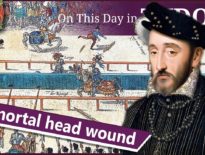On this day in Tudor history, 1st July 1535, in the reign of King Henry VIII, Sir Thomas More, Henry VIII’s former Lord Chancellor, was tried for high treason by a special commission of oyer and terminer. The commission found him guilty and he was executed on 6th July 1535.
But how did More, a faithful and loyal servant of the king, end up in this mess? Who was on the commission and what exactly happened?
Find out all about the fall of Sir Thomas More in today's talk.
Also on this day in Tudor history, 1st July 1543, in the reign of King Henry VIII, the Treaties of Greenwich were signed. These treaties were between the kingdoms of Scotland and England, and, amongst other terms, was the agreement of a marriage between Prince Edward, the future King Edward VI, and Mary, Queen of Scots. Find out more about these treaties and the subsequent war known as the Rough Wooing in last year’s video:
Also on this day in history:
- 1511 – Birth of Hadrianus Junius (Adriaen de Jonghe), physician, scholar, poet and historian, at Hoorn in the Netherlands. His contemporaries dubbed him as a “second Erasmus” and his works included “Philippeis” (1554), a poem celebrating the marriage of Mary I and Philip II of Spain, and “The Batavia”, which was the first history of Holland.
- 1536 – Parliament declared that Henry VIII’s two daughters, Mary and Elizabeth, were illegitimate. This meant that the King had no legitimate children, just three bastards, so the pressure was now on the King’s new wife, his third wife Jane Seymour, to provide a legitimate heir, and preferably a male one.
- 1555 – Execution of John Bradford, evangelical preacher and martyr, at Smithfield. Bradford was burned at the stake after being condemned as a heretic. He was influenced by his friend, Martin Bucer.
- 1572 – Death of John Clement, physician, in exile in Louvain. He was buried near the high altar of the cathedral church of St Rumbold. Clement started his career as tutor to Thomas More's children before moving into the service of Cardinal Wolsey, who sent him to be educated at Corpus Christi College, Oxford. He also studied medicine at Louvain and in Italy. On his return to England, he joined More's household and married More's adopted daughter, Margaret Giggs, before becoming a Court Physician. Clement was imprisoned in the Tower of London in 1535, along with More, for refusing to take the “Oath of Supremacy”. He was eventually released, and in 1544 became President of the College of Physicians. Clement was forced into exile in the reign of the Protestant Edward VI and Elizabeth I.
- 1582 – Death of John Harington, courtier, scholar and poet, at Stepney, London. He was buried beside his second wife, Isabell, in the church of St Gregory by Paul, London. Some of his poems can be found in the 1557 “Tottel's Songes and Sonettes”. Harington served Henry VIII and Sir Thomas Seymour, and was close enough to Elizabeth I for her to stand as godmother to his son, John, in 1560.
- 1591 – Execution of Catholic priest and martyr George Beesley in Fleet Street London. He was hanged, drawn and quartered with Montford Scott, another Catholic priest. He was condemned to death by the statute which made being a Catholic missionary priest treason in the reign of Elizabeth I. While he was imprisoned in the Martin Tower at the Tower of London, Beesley carved his name on the wall of his cell, an inscription which can still be seen today.
- 1614 – Death of Isaac Casaubon, classical scholar and ecclesiastical historian, in Drury Lane, London. He was buried in Westminster Abbey. His first major work was a commentary on the work of Strabo, the Greek geographer.
- 1622 – Death of William Parker, 13th Baron Morley and the man who discovered the Gunpowder Plot. He died in his Essex home at Great Hallingbury.
Transcript:
On this day in Tudor history, 1st July 1535, Sir Thomas More, Henry VIII’s former Lord Chancellor, was tried for high treason by a special commission of oyer and terminer. He was found guilty and was executed on 6th July 1535.
Sir Thomas More once famously said of King Henry VIII that “if my head would win him a castle in France, it should not fail to go” and I often wonder how serious he was. Was it said in jest or did More know exactly what Henry VIII was capable of? It’s impossible to know, but his closeness to the king did indeed cost him his life.
In 1531, More had refused to sign the Oath of Supremacy, declaring that Henry VIII was Supreme Head of the English Church, because he believed that this position belonged to the Pope. He offered to resign on a couple of occasions and his resignation was finally accepted by Henry in 1532. More then refused to swear his allegiance to the Act of Succession - although he accepted Parliament’s right to declare Anne Boleyn as Queen - because he could not accept the part of the Act which asserted Parliament’s authority to legislate in religious matters. In More’s opinion, only the Pope had this right. Resignation and silence was not enough for the King and his followers. More’s refusal sign the oath, and his refusal to attend Anne Boleyn’s coronation, led to him being arrested for treason on charges of “praemunire”.
On many occasions, Thomas Cromwell tried to persuade More to sign the oath but More’s conscience would not allow him to back down on matters of faith, and he ended up going to trial.
Letters and Papers, Foreign and Domestic, Henry VIII, includes a record of the commission of oyer and terminer which tried Sir Thomas More, Henry VIII’s former chancellor, for treason on 1st July 1535, including a list of those who sat in judgement on More, many of who you’ll recognise:
Sir Thomas Audley, More’s replacement as chancellor; Thomas Howard, 3rd Duke of Norfolk; Charles Brandon, Duke of Suffolk; Henry Clifford, Earl of Cumberland; Thomas Boleyn, Earl of Wiltshire; George Hastings, Earl of Huntingdon; Henry, Lord Montagu; George Boleyn, Lord Rochford; Andrew, Lord Windsor; Thomas Cromwell, secretary; Sir William Fitzwilliam; Sir William Paulet; Sir John Fitzjames; Sir John Baldwyn; Sir Richard Lister; Sir John Port; Sir John Spelman; Sir Walter Luke; and Sir Anthony Fitzherbert.
How fickle the Tudor court could be.
But what was Sir Thomas More actually charged with. Well, he was tried for high treason for denying the validity of the new Act of Succession. The indictment stated that More had traitorously attempted to deprive the king of the title of the Supreme Head of the Church; that he had written to his fellow prisoner Bishop John Fisher that “The Act of Parliament is like a sword with two-edges, for if a man answer one way it will confound his soul, and if he answer the other way it will confound his body”, something that he’d repeated during interrogations. More had held on to the belief that if he did not voice his denial of the King’s supremacy over the Church in England, then he could not be found guilty but unfortunately Cromwell produced Richard Rich to claim that he had heard More deny that the King was head of the Church. After hearing this, More spoke up and said that “no temporal man may be the head of the spirituality”.
At his trial at Westminster, More pleaded “Not guilty”, but he was found guilty under the Treason Act of 1534, and sentenced to a full traitor’s death to be carried out at Tyburn, although this was commuted to beheading on Tower Hill.
More was beatified on 29th December 1886 by Pope Leo XIII and then canonised on 19th May 1935. In 2000, Pope John Paul II declared him to be “the heavenly Patron of Statesmen and Politicians”. More and his friend, Bishop John Fisher, who was executed on 22nd June 1535, are remembered by Catholics with a feast day on 22nd June every year.



Leave a Reply